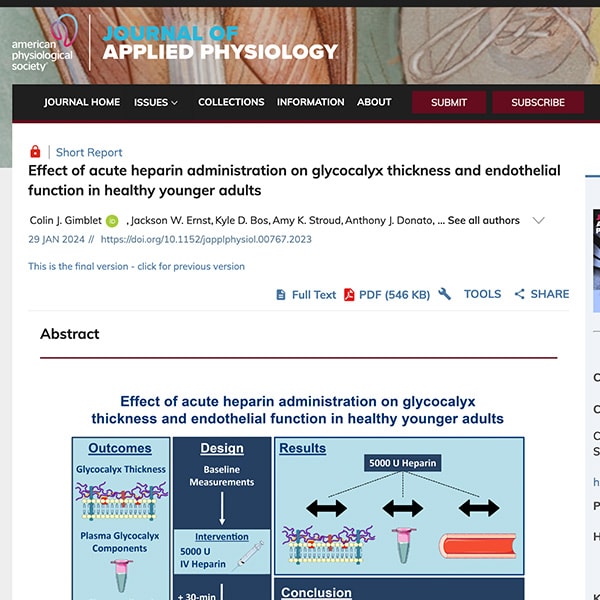
Effect of acute heparin administration on glycocalyx thickness and endothelial function in healthy younger adults
Share

Abstract
The endothelial glycocalyx is a dynamic, gel-like layer that is critical to normal vascular endothelial function. Heparin impairs the endothelial glycocalyx and reduces vascular endothelial function in a murine model; however, this has yet to be tested in healthy humans. We hypothesized that a single bolus dose of heparin would increase circulating glycocalyx components and decrease endothelial glycocalyx thickness resulting in blunted brachial artery vasodilation in healthy younger adults. Healthy adults (n = 19, aged 18–39 yr, 53% female) underwent measurements of the endothelial glycocalyx and vascular endothelial function at baseline and after a single bolus 5,000 U dose of heparin. The glycocalyx components syndecan-1 and heparan sulfate were measured from plasma samples using enzyme-linked immunosorbent assays. Glycocalyx thickness was determined as perfused boundary region (PBR) in sublingual microvessels using the GlycoCheck. Endothelial function was measured via ultrasonography and quantified as brachial artery flow-mediated dilation (FMD). Following acute heparin administration, there was no increase in syndecan-1 or heparan sulfate (P = 0.90 and P = 0.49, respectively). In addition, there was no change in PBR 4–7 µm (P = 0.55), PBR 10–25 µm (P = 0.63), or 4–25 µm (P = 0.49) after heparin treatment. Furthermore, we did not observe a change in FMDmm (P = 0.23), FMD% (P = 0.35), or plasma nitrite concentrations (P = 0.10) in response to heparin. Finally, time to peak dilation and peak FMD normalized to shear stress were unchanged following heparin (P = 0.59 and P = 0.21, respectively). Our pilot study suggests that a single bolus intravenous dose of heparin does not result in endothelial glycocalyx degradation or vascular endothelial dysfunction in healthy younger adults.
NEW & NOTEWORTHY The endothelial glycocalyx’s role in modulating vascular endothelial dysfunction with aging and disease is becoming increasingly recognized. This study presents novel findings that acute heparin administration is not a feasible method to experimentally degrade the endothelial glycocalyx and measure concurrent changes in vascular endothelial function in healthy humans. Alternative approaches will be needed to translate findings from preclinical studies and test the effects of acute endothelial glycocalyx degradation on vascular endothelial function in humans.
NEW & NOTEWORTHY The endothelial glycocalyx’s role in modulating vascular endothelial dysfunction with aging and disease is becoming increasingly recognized. This study presents novel findings that acute heparin administration is not a feasible method to experimentally degrade the endothelial glycocalyx and measure concurrent changes in vascular endothelial function in healthy humans. Alternative approaches will be needed to translate findings from preclinical studies and test the effects of acute endothelial glycocalyx degradation on vascular endothelial function in humans.
